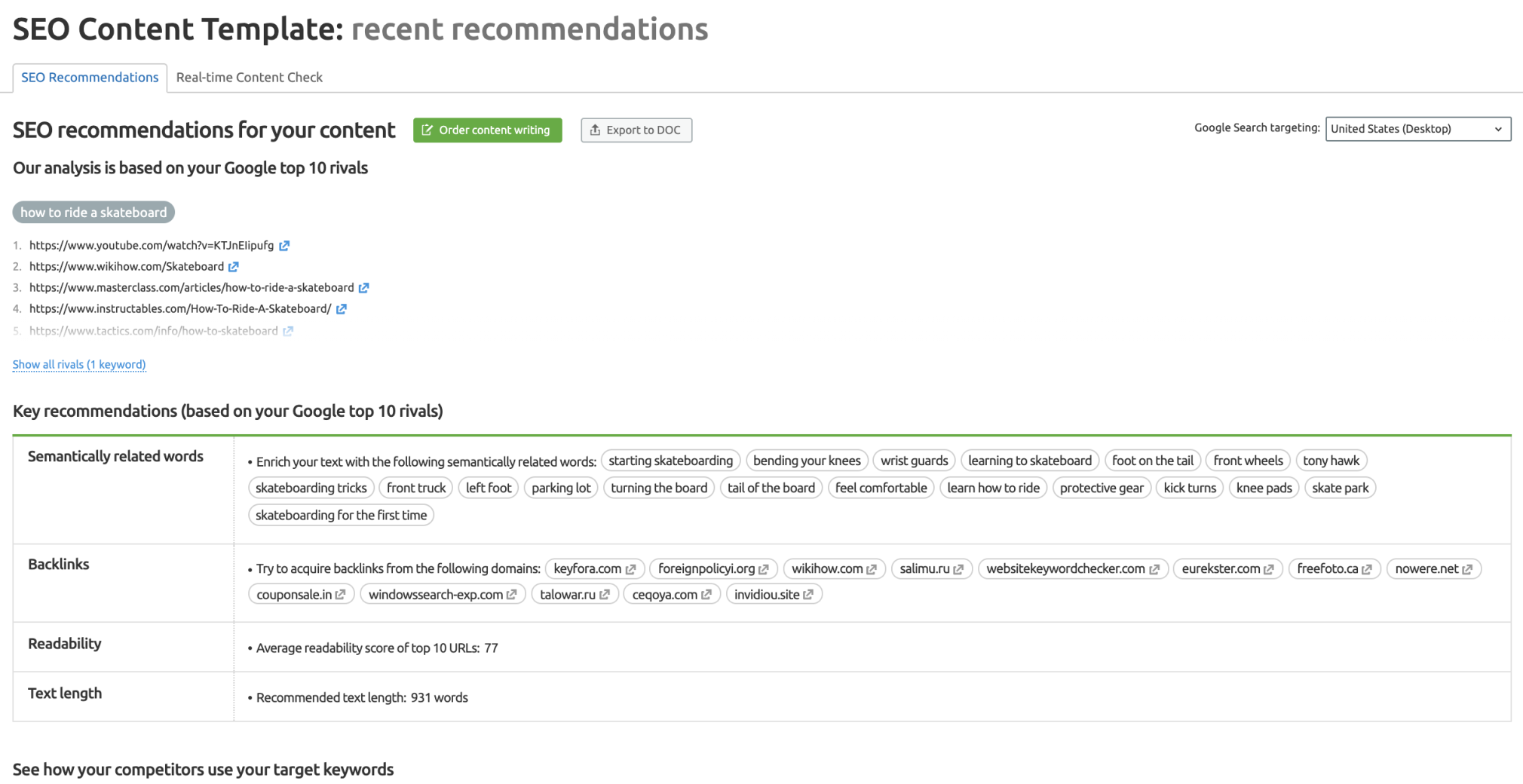When we talk about content optimization, we often referring to SEO. And this is a big part of ensuring that your content marketing strategy is successful.
What is Content Optimization?
In a nutshell, content optimization is the practice of ensuring that your text has the best possible chance of achieving its intended goal, whether that’s to rank in a search engine, or to turn existing leads into conversions.
Of course, there are a number of basic, time-tested methods that you can implement to achieve these goals, but it’s not just about performing technical tasks and ticking checklist boxes. There are also significant marketing and editorial elements to web content optimization, and they need to be covered, too.
Why is it Important?
Let’s say that you’ve written a great top-of-the-funnel blog post that’s related to your core product, and you want to get as many eyes on it as possible. Two to three months after publishing, you check the performance of the post only to find that… nobody has seen it.
Why? Well, maybe:
- the keywords you have used have no search volume;
- you haven’t used a coherent heading structure, so Google’s bots have had a hard time making sense of your article;
- your title tag doesn’t accurately reflect what the article is actually about; or
- you haven’t covered the topic in any real level of detail, especially compared to your competitors.
Essentially, if you don’t optimize your content, your piece might disappear into the Google vortex.
Alternatively, imagine that you’ve written an in-depth guide explaining how businesses can use your product effectively. This kind of content is perfect for the middle of your content funnel, and could potentially tip interested leads into making a purchase decision.
However, you haven’t included any CTAs, and the piece is targeted at junior marketers rather than decision makers. After analyzing your user journey, you realize that a high proportion of your leads drop out of your funnel completely at this point.
These are just two basic examples of why content optimization is so important. You might have written the best article in the world, full of unique insights and helpful advice. But, if search engines can’t find it, nobody’s interested in it, or it’s pitched at the wrong audience, it’s unlikely to help you achieve your content marketing goals.
To help you avoid this, we’ve compiled some helpful tips to keep you on the right path. We’ve broken down the content optimization process into three sections:
- SEO;
- backlinks and shares; and
- conversions.

Optimizing Content for SEO
In most cases, the primary goal of digital content optimization is to be visible in search engines, and there are a wide amount of factors that dictate whether or not this will happen in 2021. However, there are nine fundamental steps you can take to improve your chances.
1. Find the Right Topic and the Right Keyword
The fundamental building block of every one of your content pieces is going to be the target keyword, and so you need to identify what that keyword is going to be before preparing and writing your piece. Consider, too, that Google is now paying more attention to how you are covering the topic, which means that you need to look at related keywords, LSI (Latent Semantic Indexing) keywords and related questions as well. Remember: keywords are separate search queries that people use, while topics bridge the semantic relationship between those keywords.
There’s far more to keyword research than just identifying phrases or words that are relevant to your product or business, though. Depending on the size and authority of your brand, you also need to account for the suitability of your keyword and whether or not it meets the search intent of your target audience.
Semrush’s Keyword Magic Tool enables you to generate keyword ideas based not only on traffic volume, but by difficulty as well. If you’re a smaller, less authoritative domain, then this can ensure that you don’t overreach for broader keywords that are difficult to compete for.
2. Find LSI (Latent Semantic Indexing) Keywords
To give yourself the best chance of ranking, you should also include LSI keywords that are conceptually related to your target keyword (think “lemonade” and “ice”, “straw”). It helps search engines better understand the topic you are covering. It’s important, though, that you don’t deviate from the original intent of your article.
For instance, if you’re creating an article based on a long-tail keyword such as “how to ride a skateboard”, you can include such LSI keywords such as “bending your knees” or “shifting your weight”, but “the best beginner skateboards” — while topically related — represents an entirely different search intent.
To quickly and easily find LSI keywords for your content piece, you can use the SEO Content Template (which provides suitable suggestions at the brief stage — based on the keywords used by your top 10 organic search rivals for the selected keyword). You can also check their presence in the actual copy using the SEO Writing Assistant tool.
3. Establish Your Structure
Once you have your keywords, it’s important to outlay the structure of your piece.
The Topic Research tool is ideal for this task, as you can access a whole set of related questions for each topic based on the initial seed keyword. This helps you get a better idea of the kinds of items you’ll need to cover in your piece, helping you create a more defined structure.
You can also list ideas based on ‘Topic Efficiency’, which identifies topics that have a significant traffic volume, but are less difficult to rank for.
4. Manage Keyword Density
Many SEOs and content marketers will be familiar with the once-prominent practice of keyword stuffing, and although this “tactic” is now long defunct, you still need to pay attention to your keyword density. Use the SEO Writing Assistant tool to get alerts in case you’re using your keywords too much.
5. Add Visuals
Visuals are proven to increase user engagement with a piece of content, meaning visitors stay on your page longer and pay more attention to what you have to say.
In fact, according to a recent Semrush survey, posts with at least one image get twice as much traffic as those with text only, as well as 30% more shares and 25% more backlinks. It’s a similar story for video, too, with posts that don’t contain videos getting 92% less traffic (and 24% less shares) than those that do.
Therefore, if you’re not including photos, graphics, infographics, charts, GIFs, or videos in your posts, you are missing out on a huge opportunity. The SEO Content Template will also alert you if using video content is strongly recommended for your keyword.
6. Interlink
Internal linking is one of the most important SEO elements of content, as it allows search bots to find and rank your pages more easily, as well as pass authority from your “power” pages. It also allows human users to navigate more efficiently around your website, increasing engagement and UX (which we will discuss later).
You can use Semrush’s Site Audit tool to strengthen your internal link structure and identify pieces of content that can be improved in this regard.
7. Cover the Topic in Depth
In order to rank — especially for competitive keywords — your content needs to be comprehensive. And to understand what that means, you need to research what your competitors are serving up, and what your customers are asking about.
The goal here is to optimize your own piece by improving on what those competitors are already ranking for. You can do this by providing more value and insight through the addition of expert quotes and insights, graphics, and/or first-party statistics.
After all, even though you are covering the same topic, you want your piece to be more authoritative and more valuable than your rivals’ — not just to simply regurgitate the same points.
During this research, you should also pay attention to what people are asking about, and ensure that you provide answers to these questions. Use Topic Research to get a deeper understanding of the kinds of questions people have on the topic, and be sure to include relevant subtopics that your rivals may have overlooked.
To quickly get a deeper understanding of the top 10 search results for your keyword, you can use the SEO Content Template tool. It allows you to see the average text length and readability score of your rivals’ pieces, as well as suggests semantically related keywords and relevant domains that you should aim to acquire backlinks from.

Note: It’s worth mentioning here that “in-depth” doesn’t necessarily mean “longer”. For example, let’s say you decide to write a helpful blog post on how to choose a new skateboard.
For example, it’s a good idea to cover the different questions around choosing a new skateboard, such as “which aspects to look at”, or “where to buy”. However, writing absolutely everything you know about skateboards would not be relevant either, making your readers bounce quickly. So, always ensure that you stay relevant to the topic and the search intent.
8. Consider the Technical Elements
The technical aspects of SEO are a big part of the optimization process, and shouldn’t be overlooked or ignored. Your content could be perfectly written, but if your page takes too long to load or it’s structured in an incoherent manner, then you will have issues.
Pay particular attention to on-page elements such as UX and page speed (these factors — known by Google as Core Web Vitals — can be measured in the Site Audit tool). Ensure that you organize your meta tags, too.
9. Update Your Content Regularly
Finally, don’t ignore your existing content once it’s published. Remember point 7? Well, your competitors are going to be doing the same thing to your content, which means that you need to frequently review and update your most important pieces to keep a hold of your rankings.
This is especially true if your article is covering a fast-moving topic where trends often evolve like, say, SEO or content optimization! That’s why it’s a good idea to tweak your titles to reflect that your content offers the most relevant, up-to-date information (i.e. “The Best Skateboard Brands in 2021”).
To automate this process, use the Content Audit tool, which lets you identify articles that need to be rewritten or removed, or updated.
Always ensure that your articles contain information that is accurate and up-to-date, too, and update them with relevant internal links as you publish new content.
Optimizing Content for Backlinks and Shares
Another fundamental aspect of SEO is attracting backlinks, and this means creating content that is both linkable and shareable.
So how can you do this?
Become a “Link Magnet”
There are a number of ways (some more beneficial than others) to make your content more conducive to backlinks, such as:
- Being controversial. If you offer an opinion that goes against the grain, this can help you to stand out and attract more attention (and, thus, backlinks). Be careful, though; if your entire approach is to produce controversial content just for the sake of being controversial, your audience will eventually get wise and any long-term impact will be lost.
- Being original. Depending on what you have to say, this approach can also be considered as courting controversy, but there doesn’t necessarily have to be a negative connotation. It can simply be an original opinion or concept that has the potential to shake things up, or change the way people view or approach something. If people like your idea or your “take”, and it starts to generate some traction, this approach can result in a significant number of backlinks. Sharing unique, research-driven content is a great example. Presenting statistics and findings that don’t exist anywhere else will naturally attract backlinks from content creators using them in their own articles.
- Being authoritative. This is the approach you should try to aim for with all your content. In some niches, it’s mandatory for your content to be written and/or reviewed by a recognized expert (i.e., healthcare or nutrition), but this principle applies to any sector. If an article is written by a competent authority on a subject (or it at least contains insights and guidance from such experts), it will carry a lot more weight and be a lot more linkable.
- Taking a stand. There can be a thin line between taking a stand and being controversial, but brand values and ethics are important — especially to younger generations. By nailing your flag to a particular mast, you can generate a unique voice that makes you a more attractive backlinking option than your rivals.
- Following and Leveraging Trends. It’s a good idea to pay attention to the latest trends and topics that the backlink creators in your niche are into, and then create unique and useful content on that topic. Of course, you shouldn’t just “jump on the bandwagon” for the sake of it, but if you have something genuinely interesting to say, then this is a great way to strategize your backlinks.
- Having a recognizable voice. As mentioned, a unique voice makes you stand out and creates a sense of loyalty among your followers. For instance, Andy Crestodina has a very unique writing and talking style that is popular among marketers and business executives, allowing him to build a dedicated following that generates backlinks.
Research Backlink Opportunities
You can also generate backlinks by reaching out to relevant websites. As mentioned, the SEO Content Template tool provides you with suggestions for domains you should try to acquire backlinks from, and you can use Semrush’s Link Building tool to organize this process and contact site owners directly.
You can also use the Backlink Gap tool, which analyzes your competitors’ domains and identifies untapped backlink opportunities for your own content.
Using these tools, there are a number of tried-and-tested backlinking strategies you can adopt, such as resource page link building, broken link building, and unlinked brand mentions.
Promote Social Sharing
The best way to encourage social shares of your content is to make it as easy as possible for viewers to do so! Make your social icons clearly visible on your page, and/or encourage readers to share your content at the end of your article as a non-invasive reminder.
Ensure that the content itself is shareable, too. To do this, the content should:
- Validate your audience’s opinions. This makes it easy for people to share your content because it aligns with (and, ideally, reinforces) their beliefs and values. For this to work, though, you need to genuinely understand the sentiment of your audience, and be authentic and genuine in what you are writing about.
- Establish your sharers as experts. If your content is credible, authoritative, and accurate, then people will want to share it to establish or verify their own position as educated and informed on the subject in question. Therefore, put particular emphasis on creating content that is informative and helpful.
- Resonate with your audience. There are a number of ways that you can create emotive connections with your audience. Maybe you could post content that is inspirational and encourages a particular action. Maybe you could reference something that is important to your audience. Or perhaps you can simply tell a story that is relatable for your audience, making them want to share it with their own personal networks.
Pay very close attention to your title, too. It should be:
- specific;
- demonstrate the value of the content piece; and
- feature the keywords that will attract your audience’s attention.
Within your content, you should also include expert insights, first-hand data findings (if relevant), and visuals to make your content more consumable.
Leverage Influencers and Experts
If you are gathering insights and quotes from influencers and experts to use within your content, then you can also leverage those relationships to promote your articles once they are published. After all, they are much more likely to be willing to share your content if they are featured in it!
You can also reach out directly to other influencers in your niche, especially if your content is relevant to their brand and their following. You can use the Brand Monitoring tool to identify influencers that already talk about you online and reach out to them to establish a relationship.
Optimizing Content for Conversions
In the previous two sections, we have discussed how to optimize your content for SEO and brand awareness purposes. But for some of your content, these are not the primary goals. This is particularly the case for pieces that are strategically placed within your content funnel.
Note: Every content piece you publish should have some form of conversion path in mind, such as links to your products or gated content in the TOFU (Top of the Funnel pieces). The key is to understand where on that path your target reader is for that particular piece.
With this in mind, you should specifically focus on three key elements.
Your Target Audience
As touched upon at the start of this article, pitching your content to the right audience is crucial. If you are a B2B ads agency, for example, your content should be aimed at decision-makers, such as heads of marketing. This means using the kinds of language and terminology this audience will be familiar with, as well as having a knowledge of the pain points and challenges they are facing.
Your Call to Action
Calls to action (CTAs) are arguably the most important section of your content, especially when the goal of the content is to make readers do just that: take a certain action. Therefore, you need to ensure that you not only provide a CTA, but that it is well-positioned, well-designed, and aligned with your goals for the content.
When creating your CTA, it’s pivotal that you understand where in the user journey your readers are, too. For example, if you are sending an email about a new product to users that have just subscribed to your newsletter from a TOFU blog post, the majority of those folks might not be at the purchase decision stage yet.
However, if you are sending an eBook or a Case Study, these users would be far more likely to click and engage, allowing you to nurture them along your funnel instead of “scaring” them away.
Your Writing Style
When writing with conversions in mind, you need to approach your task slightly more persuasively — but without coming on too strong. This is a particularly difficult balancing act known as conversion copywriting.
Within this method, be specific with the actions you want your reader to take, even if that means bending words and phrases to make your point. You also need to have a strong understanding of what your audience wants and how they like to be communicated with. You should try to:
- Format your copy effectively. Grab your audience’s attention, and make it easier to digest key information by using lists, numbers, comparison tables, and bullet points.
- Focus on the reader’s needs — not yours. For example, when it comes to BOFU (Bottom of the Funnel) content, it’s all well and good talking about how amazing your product is. Yet, the only thing readers really want to know is if — and how — it solves their own problem. Focus on the benefits of the product, rather than the product itself.
- Punctuate effectively. Punctuation is absolutely crucial in copywriting, as it allows you to break up sentences and make them more readable. It also allows you to emphasize tone or intent (although there is such a thing as too many exclamation points).
- Utilize relevant adjectives. You don’t have to describe every single noun in your copy as “amazing”, “awesome”, or “groundbreaking”, but a well-placed adjective can make a subtle but sizable difference in the perception of your reader.
- Be conversational — not salesy. In your copy, don’t talk at people; talk with them. In many cases, it’s acceptable to adopt an informal tone and speak in the first person, as opposed to bombarding readers with sales fluff and grandiose claims. For your readers, the former feels like a conversation, whereas the latter sounds like a hard sell.
Final Thoughts
Content optimization should be a crucial component of your wider content strategy, as it gives you the best possible chance to rank for your target keywords, build authority as a brand, and convert leads into paying customers.
A big part of this is to remember that you should write for humans as opposed to writing for search engine bots, and apply what you have learned during your competitor analysis and research. The tools mentioned in this article allow you to conduct and streamline many of these tasks and activities, ensuring that your content is perfectly positioned to succeed both before and after publication. #KhabarLive #hydnews








[…] Source link […]
Comments are closed.